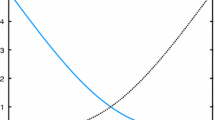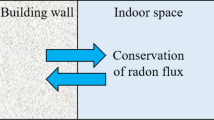Abstract
Radon is one of the main causes of environmental pollution and lung cancer. The precipitation of radon from porous media is affected by the coupling of heat and moisture, which has not been considered in the existing knowledge. We present a model for predicting radon migration in porous media. This model combines the heat-air-moisture (HAM) coupling model of porous media with a radon migration model to establish three-dimensional partial differential equations for steady-state radon migration under HAM coupling conditions. The finite element method (FEM) was used to obtain a numerical solution. Experimental verification showed that the model had high calculation accuracy; the calculated maximum relative error did not exceed 15%. The results of the model were compared with the results of a conventional model that does consider the coupling of heat and humidity; the results showed significant differences in the radon concentrations and radon flux distribution curves for the two models. The newly developed model revealed that there is a significant coupling effect between migration and the distribution of the temperature field, the humidity field, and radon flux in unsaturated porous media. The radon exhalation rate on the surface of porous media increases linearly with the increase of permeability. The exhalation rate decreased exponentially with the increase in relative humidity. When the trend of the temperature gradient was consistent with the concentration gradient, the radon exhalation rate decreased linearly with the increase in temperature gradient. We establish a new model to study the radon migration in porous media under the coupling of heat and moisture. The model provides a theoretical basis for an effective and accurate analysis of the impact of radon exhalation on the environment.









Similar content being viewed by others
References
Ajayi KM, Shahbazi K, Tukkaraja P, Katzenstein K (2018) A discrete model for prediction of radon flux from fractured rocks. J Rock Mech Geotech Eng 10(05):79–92. https://doi.org/10.1016/j.jrmge.2018.02.009
Ajayi KM, Shahbazi K, Tukkaraja P, Katzenstein K (2019a) Estimation of radon diffusivity tensor for fractured rocks in cave mines using a discrete fracture network model. J Environ Radioact 196:104–112. https://doi.org/10.1016/j.jenvrad.2018.11.003
Ajayi KM, Shahbazi K, Tukkaraja P et al (2019b) Numerical investigation of the effectiveness of radon control measures in cave mines. Int J Min Sci Technol 29:469–475. https://doi.org/10.1016/j.ijmst.2018.07.006
Ali FSA, Mahdi KH, Jawad EA (2019) Humidity effect on diffusion and length coefficient of radon in soil and building materials. Energy Procedia 157:384–392. https://doi.org/10.1016/j.egypro.2018.11.203
Chong KP (2017) In Numerical methods in mechanics of materials. Boca Raton, London
Dempsey S, Lyons S, Nolan A (2018) High radon areas and lung cancer prevalence: evidence from Ireland. J Environ Radioact 182:12–19. https://doi.org/10.1016/j.jenvrad.2017.11.014
Ferroukhi MY, Djedjig R, Belarbi R, Limam K, Abahri K (2015) Effect of coupled heat, air and moisture transfers modeling in the wall on the hygrothermal behavior of buildings. Energy Procedia 78:2584–2589. https://doi.org/10.1016/j.egypro.2015.11.293
Ferry C, Richon P, Beneito A, Cabrera J., Sabroux J.C. (2002) An experimental method for measuring the radon-222 emanation factor in rocks. Radiat Meas 35: 579-583.https://doi.org/10.1016/S1350-4487(02)00092-6
Finne IE, Kolstad T, Larsson M, Olsen B, Prendergast J, Rudjord AL (2019) Significant reduction in indoor radon in newly built houses. J Environ Radioact 196:259–263. https://doi.org/10.1016/j.jenvrad.2018.01.013
Geng W (2009) Study on heat and mass transfer with cross diffusion effects in multi-physical fields. Dissertation, Shandong University.
Gogna P, Narain TA, O’Sullivan DE et al (2019) Estimates of the current and future burden of lung cancer attributable to residential radon exposure in Canada. Prev Med 122:100–108. https://doi.org/10.1016/j.ypmed.2019.04.005
Hakl J, Csige I, Hunyadi I, Várhegyi A., Géczy G. (1996) Radon transport in fractured porous media—experimental study in caves. Environ Int 22: 433–437. https://doi.org/10.1016/S0160-4120(96)00143-2
Holford DJ, Schery SD, Wilson JL, Phillips FM (1993) Modeling radon transport in dry, cracked soil. J Geophys Res 98:567–580. https://doi.org/10.1029/92JB01845
Ishimori Y, Lange K, Martin P et al (2013) Measurement and calculation of radon releases from NORM residues. Technical Reports Series No 474.Vienna,Austria
Janik M, Omori Y, Yonehara H (2015) Influence of humidity on radon and thoron exhalation rates from building materials. Appl Radiat Isot 95:102–107. https://doi.org/10.1016/j.apradiso.2014.10.007
Jiránek M, Kačmaříková V (2019) Radon diffusion coefficients and radon resistances of waterproofing materials available on the building market. J Environ Radioact 208–209:106019. https://doi.org/10.1016/J.JENVRAD.2019.106019
Kar A, Chatterjee S, Ghosh D (2019) Multifractal detrended cross correlation analysis of land-surface temperature anomalies and soil radon concentration. Physica A: Statistical Mechanics and Its Applications 521:236–247. https://doi.org/10.1016/j.physa.2019.01.056
Liu F, Jia B, Chen B, Geng W (2017) Moisture transfer in building envelope and influence on heat transfer. Procedia Engineering 205:3654–3661. https://doi.org/10.1016/j.proeng.2017.10.229
Maliki M, Laredj N, Bendani K et al (2017) Two-dimensional transient modeling of energy and mass transfer in porous building components using COMSOL multiphysics. Journal of Applied Fluid Mechanics 10:319–328. https://doi.org/10.18869/acadpub.jafm.73.238.26484
Mentes G, Eper-Pápai I (2015) Investigation of temperature and barometric pressure variation effects on radon concentration in the Sopronbánfalva Geodynamic Observatory, Hungary. J Environ Radioact 149:64–72. https://doi.org/10.1016/j.jenvrad.2015.07.015
Misdaq MA, Amghar A (2005) Radon and thoron emanation from various marble materials: impact on the workers. Radiat Meas 39:421–430. https://doi.org/10.1016/j.radmeas.2004.06.011
Mosley R B, Menetrez M Y, Snoddy R, Brubaker Jr S.A. (1996) The influences of diffusion and advective flow on the distribution of radon activity within USEPA’s soil chamber. Environ Int 22:521-533. https://doi.org/10.1016/S0160-4120(96)00154-7
Papachristodoulou C, Ioannides K, Spathis S (2007) The effect of moisture content on radon diffusion through soil: assessment in laboratory and field experiments. Health Phys 92:257–264. https://doi.org/10.1097/01.HP.0000248147.46038.bc
Rogers VC, Nielson KK (1991) Correlations for predicting air permeabilities and 222Rn diffusion coefficients of soils. Health Phys 61:225–230. https://doi.org/10.1097/00004032-199108000-00006
Rowberry MD, Martí X, Frontera C, van de Wiel MJ, Briestenský M (2016) Calculating flux to predict future cave radon concentrations. J Environ Radioact 157:16–26. https://doi.org/10.1016/j.jenvrad.2016.02.023
Tariku F, Kumaran K, Fazio P (2010) Transient model for coupled heat, air and moisture transfer through multilayered porous media. Int J Heat Mass Transf 53:3035–3044. https://doi.org/10.1016/j.ijheatmasstransfer.2010.03.024
Ting DS (2010) WHO handbook on indoor radon: a public health perspective. Int J Environ Stud 67:100–102. https://doi.org/10.1080/00207230903556771
Zhuo W, Iida T, Furukawa M (2006) Modeling radon flux density from the earth’s surface. J Nucl Sci Technol 43:479–482. https://doi.org/10.1080/18811248.2006.9711127
Funding
This research was supported by the National Natural Science Foundation of China (Nos. 11705083, 11575080), the National Natural Science Foundation of Hunan Province (No. 2019JJ50488), the China Postdoctoral Science Foundation (No. 2018M632975), and the 2019 Annual Joint Fund Project of Hunan Province Engineering Research Center of Radioactive Control Technology in Uranium Mining and Metallurgy & Hunan Province Engineering Technology Research Center of Uranium Tailings Treatment Technology, University of South China (No. 2019YKZX1009).
Author information
Authors and Affiliations
Corresponding author
Additional information
Responsible Editor: Georg Steinhauser
Publisher’s note
Springer Nature remains neutral with regard to jurisdictional claims in published maps and institutional affiliations.
Rights and permissions
About this article
Cite this article
Cui, Y., Feng, S., Chen, P. et al. Heat-air-moisture coupled model for radon migration in a porous media. Environ Sci Pollut Res 27, 32659–32669 (2020). https://doi.org/10.1007/s11356-020-09374-z
Received:
Accepted:
Published:
Issue Date:
DOI: https://doi.org/10.1007/s11356-020-09374-z




